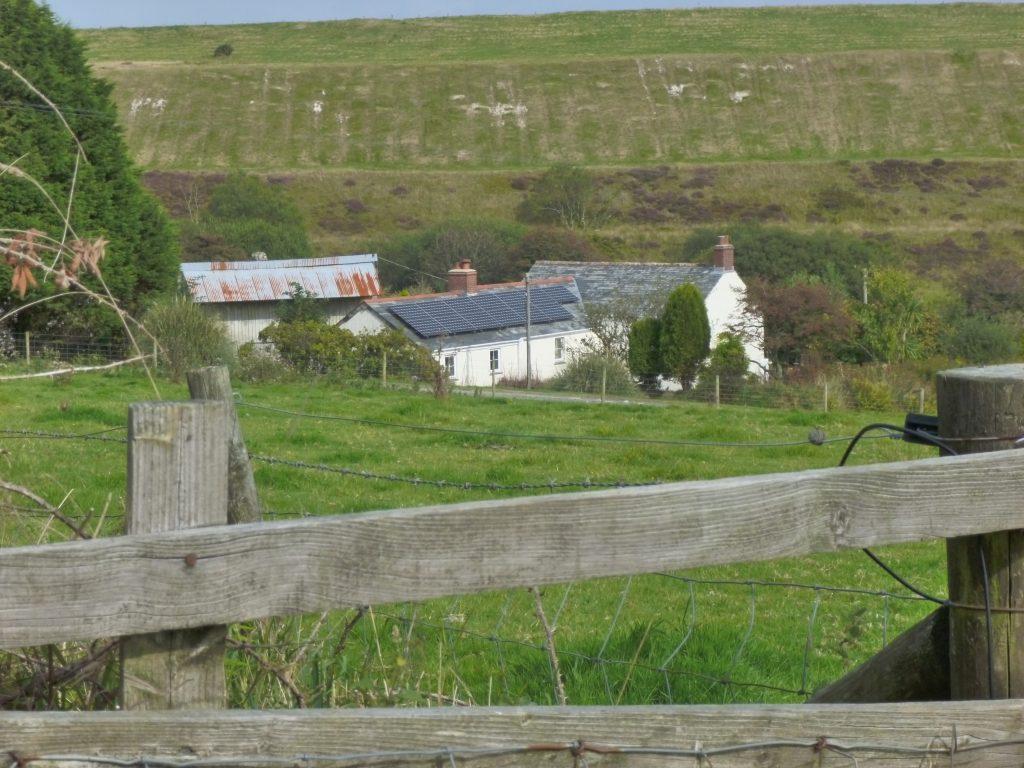Pre-record Cornish Sweets (Swet)
Our Cornish Sweet family is an ancient one – from the mouth of the River Fowey on the coast to its source on Bodmin Moor. The earliest records of Sweet families around Britain go back to the Viking kings – Cnut and Harthacnut. There are coins cast by the Swet moneyers with reference to Cnut and Harthacnut stamped on them. Only a handful (86) of moneyers were officially appointed by the king to hold the coin-casting dyes, and the Sweets held at least one set of those dyes. Viking coins derived from Swet have been uncovered in Somerset, Dorset, London and Bedfordshire. So the Sweets were allied to or at least trusted by the Viking kings. Tradition had it that the dyes were past down from father to son.
Whether they were Saxons or Vikings is yet to be confirmed. Also to be confirmed is whether the name Sweet, (Swet, Swete, Swett, Swette, Suet, Suot) derives from sweetness of temprament or in actual fact from Scandinavian words derived from “sut” or soot (a bit like “smith” from blacksmith). Further, I am intrigued by the location of the earliest Sweets on farmsteads which bear the name “Sutton” and even a farmstead called “De Swetton” in Norman records. They are spread across the country from Lincoln to London, Gloucestershire, Somerset and Devon. Medieval Cornish Sweets also named their leasehold farmsteads – Sweetshouse, near Withiel for example.
In the Domesday Book there were a number of Saxon thanes who bore the name Sweet or its derivatives – Swetric, Sweeting or Sweetman. The suffix “ric” denotes a “leader” of the family or a branch of it. Those who were named Sweet (also spelt Suet, Swet, Swete) still lived in locations with names relating to Sutton or De Swetton. Just like the coins, some of the places where the thanes were recorded in 1086 were also near to silver and tin mines, wool towns and trading routes. After the Norman Conquest it appears that many Sweets did not thrive. They lost land as their new Norman, feudal masters took titles and deeds and sidelined the Saxon-Viking population.
Are any or all of the Sweets scattered around the country connected to a common patriarch or was it just a very common name at the time? The Sweets in Cornwall may not have had coats of arms or high status, especially after the Norman Conquest, but they do appear in records as far back as 1200s. Given the link to the Viking kings, Cnut and Harthacnut, and to their locations near to sources of precious metals, it is just possible that the Cornish Sweets, tinners of the ancient Foweymore stannary, go that far back into history too as moneyers or miners.
What is certain is that the Cornish Sweets do not descend from the Devonshire Sweets, with their much touted coat of arms. My ancestors, the Cornish Sweets, pre-date the extinction of the Devonshire Sweets of Modbury (Traine) by over 400 years! So, if you are related to my line, ignore any family trees bearing the Modbury/Traine coat of arms! Below are the earliest records known for Cornish, Bodmin and Fowey Sweets.
There are 2 very distinct and separate Sweet family lines which lived in close proximity to each other but without any records of interaction. The Fowey Coastal Sweets and the upper Fowey Moor Sweets. They are likely to have been very distant cousins, and a common patriarch could have existed at some time between 1200s-1400s. The fortunes of Fowey Coastal Sweets rapidly improved through privateering, piracy and roles of responsibility in connection with the Cardinham (Dinham) family. The fortunes of the Fowey Moor Sweets did not improve. I am descended from the Fowey Moor Sweets.
Galfridus Sweet – Fowey Coastal?
1229
Galfridus Sweet’s record relates to Dunterton, near Launceston and confirms a very early and enduring link to the Dinham family (Cardinham) which continued for the Lanlivery/Fowey Coastal branch of Sweets into the 1500’s
Gilbert Sweet – Fowey Coastal or Moor – TBC
1200’s
Gilbert Sweet’s record connects him to a son called Stephen in a place called Redmore. There are 2 locations which match the Redmore reference. One is next to Dozmary Pool on Bodmin, right the heartland or our ancestral line. The other is near Lanlivery and that Sweet line has plenty of references to Redmore too!
Mark Sweta – Fowey Moor?
1302
Mark Sweta was murdered on Launomur near St Teeth and Altarnum – a grisly event on Bodmin Moor.
John Swet – Fowey Coastal?
1371
John Swet was entangled in a case of theft and piracy which involved men being assaulted and wine stolen.
John Sweet – unknown
1391
A John Sweet was granted the “tynbaile” of Tynwarnhaile – part of the patronage of roles handed out by nobility or royalty which encroached on the stannary system. It was awarded to John in recognition of his service to the king (possibly military)
Robert Sweet – Fowey Moor?
1405
Debt defendant in St Columb
Johannes Sweet – Fowey Coastal?
1511
Johannes was embroiled in a case of piracy, acting as surety to another man, Martyn of Redmore (neighbour, fellow tenant?) who was accused of piracy.
Richard, John, Nicholas – Fowey Coastal
1441, 1455, 1471, 1580
Service to the Dinham family continued right into the 1500’s from the 1st record known of Galfridus in 1229. John was reeve of Bodardle for John Dinham in 1441, Richard was reeve of St Columb for Dinham, Nicholas was tithing man for Bodardle Manor in 1580. These Sweets were based around Lanlivery, associated with Redmoor and/or Roselath and were probably linked and built wealth and influence as part of the Fowey Gallants in 1400s
Historical records
1348, 1557, 1652
Plague and Black Death wipe out Bodmin and Fowey; vacant farmsteads become available to serfs, feudalism declines, landlords need to pay workers to bring them on to their land.
1337-1453
100 Years War gives rise to the Fowey Gallants; sailors could be prosecuted for piracy within a day of letters of Marque being issued.
1500-1600s
Tensions with Spain and the scourge of Ottoman slavers off Cornish coast – Corsairs
Route 1: My oldest recorded ancestor – ‘John of Penkestle’, father of Nicholas, possibly son of Robert
The Dissolution of the Monasteries, 1536-1541, led to the destruction of parish records. Nicholas (b1568) is the last ancestor for whom we have a baptism record on which a father, John, is named. I have >90% confidence that Nicholas is my ancestor and 95%-99% confidence that his descendents are my ancestors. I can only be 60% confident about which John who was living in the parish at the time is Nicholas’ father. No records exist for John’s birth but through a process of triangulation, acccounting for all contemporaneous John Sweets – using taxation, muster rolls, baptisms, marriages, deaths – I have built a life story which supports the most probable candidate. Mention of a 3-lives lease at Penkestle also helps to strengthen his claim.
I’ll call him “John of Penkestle” to help differentiate him. John of Penkestle was born between 1500-1519, appears in the 1535 and 1569 muster rolls. The age for a muster was 16 to 60 years old. At 16 he had no skill listed (e.g. archer).
Records refer to a “John of Penkestle”, a farm within a stone’s throw of Lords Park Farm, on Bodmin Moor. My ancestral Sweet family remain linked to Penkestle until the 1700s. William (1608) married Mary Coyler, in what is referred to as Coyler’s Tenement at Penkestle.
There are other Sweets who are “generational” contemporaries and are likely to be siblings or cousins to John of Penkestle. Some or all (Nicholas, Raphe, William, Richard, Stephen, Thomasine) may be descended from:
|
Robert b1470-90s, 1525 subsidy roll, 1535 muster roll, archer
Stephen b1480s, 1522 military survey
or William b1470-80s, 1522 military survey, 1525 subsidy roll
They are all linked by the Foweymore muster rolls, lease / tenancy records, St Neot parish and family connections between wives (marrying women within the same family – Reed, Rowe, Parnall, Tapprell, Cowlinge, Goord). My preferred candidate for father of John of Penkestle is Robert Sweet because of the timing and length of a legal dispute relating to Tredawle Moor between Robert and John.
John of Penkestle’s contemporaries, potential siblings or cousins

Nicholas
1520’s – 1606
St Neot
m
Alse (-1596)
1606 will mentions children:
John
Elizabeth
Walter
Thomas
William Sargent
possible 2nd marriage?

Thomasine
1533 –
m
John Johns
(1535 – 1583)
of Trevigo

John
1500’s – 1596/1576
Foweymore muster 1535, 1569
St Neot
“of Penkestle”
m
1st wife: Elizabeth (-1573) mother to John 1549, Jane 1555, Stephen 1557, Bennet 1560, Maryn 1563, Nicholas (1568), Thomas (1571), Orphew (1573)
2nd wife: Kathrine Reed (-1592) in 1576, mother to Ann, Elizabeth

Raphe
1500’s – ?
St Neot
Foweymore muster 1535, 1569 ‘archer’
m
1st wife: Elizabeth 1505-1558
2nd wife: Katherine Rowe in 1559
|
John 1559, Stephen 1562
Maryn 1563 may be dau of Raphe or John

William
1500’s
St Neot
Foweymore muster 1535

Richard
1500’s
St Neot
no info yet

Stephen
1500s
St Neot
Foweymore muster 1535
m Joan d 1591
son (?) John d 1560
Route 1: Nicholas & Elizabeth Cowling
My 10X GGP born in Elizabeth I’s reign
My 11XGGF, John of Penkestle, married a woman called Elizabeth some time between around the 1540’s. They are likely parents of John b1549, Jane b1555, Stephen b1557, Bennet b1560, Maryn b1563, Nicholas b1568, Thomas b1571 and Orphew b1573. Elizabeth died in 1573, probably in childbirth (Orphew). They also had at least 1 child who died in infancy, Pasca (d1570) and she may have been Nicholas’ twin sister. All the children were born in St Neot parish where Penkestle Farm was located.
John of Penkestle may have relied on his eldest daughters Jane (13) and Maryn (10) to raise 3 year old Orphew, 4 year old Thomas and my 10X GGF, 5 year old Nicholas, even as they grieved the loss of their mother. I have no record of Jane marrying but a Maryn married Cleere Gourd in 1584. More of them later…
My 10X GGF, Nicholas, married Elizabeth Cowling in 1603 in St Teath. They are parents to my 9X GGF William (b1608) who married Mary Coyler in 1629.
As with Nicholas’ own mother, his 1st wife Elizabeth Cowling dies in 1621, shortly after giving birth to Elizabeth in 1620 who also dies in 1621. They lost several other children – Edward 1606, Edward 1612, possibly Jone or Jane too.
After Elizabeth Cowling died in 1621, Nicholas was left with William (b1608) who was old enough to look after himself, Charis (b1618) and Thomasine (b1620) who were still too young to be left (aged 3 and 1 respectively). So Nicholas married Grace Pulpe in 1625 in St Neot. She was considerably younger than him – by now he was 63, she was 22. She is cited as a widow in 1659, which indicates Nicholas’ likely time of death. Grace had 2 children from Nicholas – Thomas (b1625) and John (b1626).

John
1549 – 15?
St Neot
m Katherin Reed in 1576
John 1576 d infant
Ann 1586
Stephen d 1590
Elizabeth 1591

Jane
1555 – 1608
St Neot
info to come

Stephen
1557 – 1632
St Neot
m
1st wife: Thomasine Parnall in 1576 (dies 1581)
|
Stephen 1580 – 1648
Jane ?
2nd wife: Alse Robyns in 1600
|
William 1601 – 1674
John 1603-4
Alse 1605 – 1668
Agins 1609

Bennet
1560 – 1640
St Neot
m
Elizabeth Reed 1589 (d1654)
|
Frances 1590-1648
Stephen 1592 – 1659
Nicholas 1602 – 1629
Jane 1602 – 1671

Maryn
1563
St Neot
m
Cleere Gourd in 1584 (note Furzewain lease)

Nicholas
1568 – pre 1659
St Neot
m
1st wife: Elizabeth Cowling
(1584 – 1621)
in 1603 in St Teath|
|
William 1608
Jane / Jone 1614
Charis 1618
Thomasine 1620
Elizabeth 1620-1621
2nd wife: Grace Pulpe
(1602 – 1659)
in 1625 in St Neot
Grace dies ‘a widow’
|
Thomas 1625
John 1626

Thomas
1571 – 1624
St Neot
m
Bersalie Tapprell
in 1604
|
Grace d 1604
Thomas 1605 – 1621
Ragedon 1608 ?
Symen 1611 ?
Alice 1613 – 1624

Orphew
1573 – 1614
St Neot
m
Jone Law
in 1598
Her will 1680 (?) bequeaths to nieces and nephews William, Martha and Grace
Route 1: William & Mary Coyler
9X GGP living through Civil War
William had to adapt to the arrival of his father’s very young wife, Grace, who was only 9 years older than him, and in addition, the arrive of 2 new half siblings, both male.
William’s life would have revolved around the farmstead where his father held a 3-lives lease, which William was destined to inherit. He cemented his right of tenancy in Penkestle and may have expanded his or the family’s share of the property by marrying Mary Coyler of Coyler’s Tennement, Penkestle, in 1629 (in St Neot Church). William then held a 3 lives lease with 1 life remaining after his own, for a portion of living space and land at the property which he then handed down to his son John (b1629), but he may also have appended a new 3 lives lease to the property through his marriage to Mary. Click on William’s records to see a map of the farmsteads known to be occupied by Sweet ancestors.
William appears in Hearth Returns in 1664, alongside his son John, but there appear to be no protestation returns (1641) for his generation in St Neot. The Fowey Coastal Sweets, living in Sweetshouse, Redmoor, near Withiel, found themselves right in the heart of an infamous Civil War battle, written about by Daphne De Maurier in the King’s General. Fighting came close to the Fowey Moor Sweets at Braddock Down but perhaps the marshy bleak nature of Bodmin Moor protected them from too much incursion!

William
1608 – 1674
m
Mary Coyler
(1598 – 1687)
in 1629 in St Neot
|
John 1629
Rebecca
Thomas
Hearth Tax 1664

Jane
1614 –
m
William Burnard
in 1640

Charis
1618 –
no info – possibly also ‘Charles’

Thomas
1625 – 1664
no info

John
1626 –
no info
Route 1: John & Ann Isak
8X GGP from Civil War to Tea
John Sweet 1629 was a child in the midst of the Civil War and other key historical conflicts. Civil War had ramifications for him and his father, William. Would his father be press-ganged? Would there be conflict with neighbours on opposing sides (royalists, parliamentarians) or, worse still, with their landlords? How would they manage if their livestock was taken to feed hungry soldiers, their wives and daughters threatened with rape, their crops trampled on and destroyed?
John was one of just 2 surviving children. He had a brother, Thomas, but his sister, Rebecca, died in infancy. His own parents, William and Mary, who are named on his baptism certificate, lived to a good age. William died in 1674. Mary died in 1687. So John may have had caring responsibilities or at least had to work a living for both his wives, children and his parents.
John’s first wife, Ann Isak, is my 8X GGM. She was born in 1612, so older than her husband John, and by the time they married in 1654, she was 42 years old. They had just one son together, John in 1655 and she died in 1671. Isak is variably spelt Isack, Isacke, Isake. Her siblings were Agnes (b1610), Grace (b1611) and Francis (b1616). Her father, Johannis Isak (b1567), married Elizabeth Ottram in 1594, but Ann’s mother was his 2nd wife, Rose Duranse (Durant) whom he married in 1606. They were a St Neot family, so it is highly likely that Nicholas and her father, Johannis, knew each other quite well.
A year after Ann’s death, in 1672, John (b1629) married for a 2nd time, to Dorothie Rogers in St Neot. He may have been anxious to insure his descendency against the risk of child mortality, with diseases and political upheaval all around. John and Dorothie subsequently had 4 children – William (b1673), Joseph (b1677), Grace (b1678) and Walter (b1681).
The remainder of the Penkestle 3 lives lease did pass on to his son, John (b1655) but it had been much reduced during his father William’s lifetime and ended up expiring and being transferred out of Sweet control in 1719.
John b1629’s will, released in 1708, bequeaths: John b1655 40 shillings, Joseph ?pounds, Walter 6 pounds. He also mentions his daughter Grace and his 2nd wife, widow, Dorothie, who was bequeathed 2 pounds and 10 shillings a year if she did not remarry. What he bequeathed to William is illegible but William died a year after his father’s will was released. Thomas, from his 1st marriage, is not mentionned in his will as he predeceased his father (in 1683). Also mentionned is Charles, who is likely to be his daughter Grace’s husband, Charles Pedler. 40 shillings is the equivalent of 20 days skilled labour. Walter inherited more – the equivalent of a cow, a horse, some wheat and wool or 66 days of skilled labour. However Walter would not have inherited a property lease. Walter shared tenancy of Tremaddock with his brother William in the 1700s and they may have thrived well enough for Walter to get some form of education – he was a parish clerk and ‘yoeman’ by 1726.

John
1629 – 1708
m
1st wife: Ann Isak
(1612 – 1671)
in 1654 in St Neot
|
John 1655
2nd wife: Dorothie Rogers
(16?? – 1728)
in 1672 in St Neot
|
William 1673
Joseph 1677
Grace 1678
Walter 1681
Hearth return 1664
Will 1708

Rebecca
1632 – 1633
died an infant

Thomas
1633 – 1683
m
Jane
(1631 – 1667)
in 1658
Key Locations
Lorem ipsum dolor sit amet, consectetur adipisicing elit, sed do eiusmod tempor incididunt ut labore et dolore magna aliqua. Ut enim ad minim veniam, quis nostrud exercitation ullamco laboris nisi ut aliquip ex ea commodo consequat.

